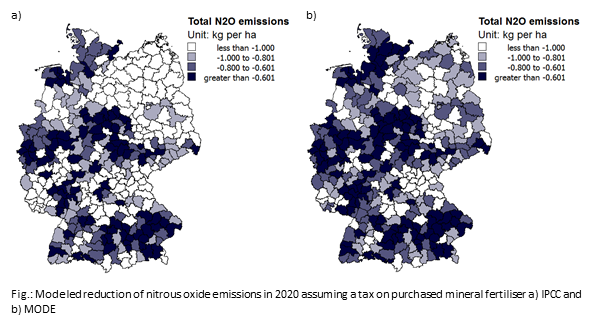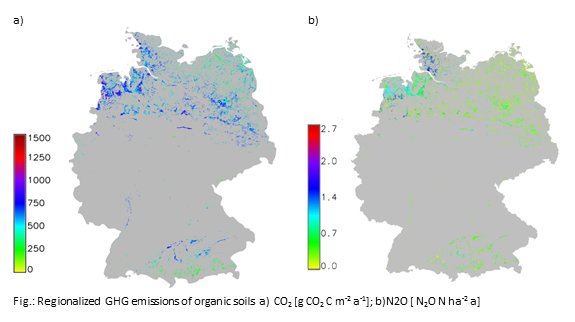Greenhouse gases
Title of the subproject:
Modelling impacts of land management on greenhouse gas (GHG) emissions from German agriculture and forestry
Introduction:
Two aspects indicate that landuse has to be considered when planning greenhouse gas mitigation options:
- GHG emissions originating directly or indirectly from land use are highly relevant within Germany total GHG emission amount. Approximately 10 % of Germanys reported GHG emissions (NIR, 2010) originates from the sectors agriculture, land use, land use change and forestry. At least three key sources in these sectors are identified by the NIR (2010).
- The substitution of fossil fuels by bioenergy is a core element of Germanys GHG reduction strategies. A decreased dependency on fossil fuel imports and an elevated added value in agriculture are further aspects supporting the establishment of biomass production (Breitschuh et al. 2009).
The potential of land areas used to act as a GHG sink by far exceeds the magnitude of net GHG emissions reported.
Sustainable land management strategies, such as those developed in CC-LandStraD, will require scientific description and modeling of GHG emissions and their dependence on natural and anthropogenic drivers.
Institution:
Thünen Institute of Climate-Smart Agriculture
Aims
This project addresses the following scientific objectives:
- Improvement of present state-of-the-art approaches to quantify greenhouse gases (GHG) fluxes in managed soils, animal husbandry and farm fertilizer by a detailed quantitative description of cause- effect relationships between natural and anthropogenic drivers on GHG emissions.
- Development of modelling tools that improve the quality and detail of the German national GHG emission reporting in the sectors agriculture, land use and land use change by enhanced regional differentiation and new GHG mitigation measures.
- Quantification of GHG reduction potentials and of antagonistic effects of individual measures on emissions of the individual species CH4, N2O und CO2 along the agricultural production chain.
Research approach and methods
The project, "Modelling impacts of greenhouse gas emissions from German agriculture and forestry", will develop and apply a range of process-based to empirical models within CC-LandStraD to quantify present and future greenhouse gas (GHG) emissions from agriculture and forestry in Germany. The models will differentiate between man-made and natural impacts. The models work explicitly in terms of space and time. It is therefore possible to describe past to present GHG emissions (since 1990) and their dependence on climatic, soil and management conditions. Further it will be possible to calculate emission potentials and reduction potentials (hot spots/hot moments).
Based on the model results this project will evaluate the GHG technical mitigation potential of land management strategies and land use change to support the iterative process of stakeholder tailored scenario building and assessment in CC-LandStraD and will quantify GHG emissions of future land use scenarios when coupled to the economic and climate impact models of the model network in the joint proposal CC-LandStraD.
The following GHG fluxes will be studied:
- CH4 and N2O sources and sinks in mineral soils used for agriculture and forestry,
Model: Fuzzy logic inference schemes - N2O, CH4 and CO2 sources and sinks in managed organic soils
Model: Fuzzy logic inference schemes and nonlinear regression approaches - GHG emissions from animal husbandry and farm fertilizer.
Model: GAS-EM
Co-working with other subprojects in CC-LandStraD:
There is a strong collaboration with the subproject agricultural economics (RAUMIS).
References:
Breitschuh T., Eckert H., Maier U., Gernand U., Müller A. (2009):
Folgeabschätzung einer zunehmenden Bereitstellung von Bioenergieträgern auf die Nachhaltigkeit landwirtschaftlicher Unternehmen, bewertet mit dem Kriteriensystem Nachhaltige Landwirtschaft (KSLN).
Texte 20/2009 Umweltbundesamt. German
NIR. 2010:
Deutsches Treibhausgasinventar 1990 – 2007; Nationaler Inventarbericht 2010. Berichterstattung unter der Klimarahmenkonvention der vereinten Nationen.
Umweltbundesamt. Berlin. German
Results
1. The efficiency of mitigation strategies on the example of direct nitrous oxide emissions from agricultural soils in Germany
Agricultural soils are an important source of nitrous oxide, a greenhouse gas whose global warming potential is around 300 times that of carbon dioxide. Therefore nitrous oxide emissions from soils contribute around 40 % to total GHG emissions from German agriculture. In soils, nitrous oxide is produced by microbial processes. The availability of reactive nitrogen, coming from mineralisation or fertilisation activities, is one of the most important key drivers of nitrous oxide production. Beyond available nitrogen and carbon sources geophysical and geochemical conditions in the soil determine whether and how much nitrous oxide is being produced. In contrast to widely applied emission factor approaches, the empirical model MODE estimates the influence of geophysical and geochemical properties by proxies of meteorological data, soil properties and land use data (Dechow and Freibauer et al. 2011)
Aiming to examine the regional influence of mitigation strategies the model MODE was coupled to the agro-economic model RAUMIS by regionally stratified emission factors generated by MODE. National nitrous oxide emissions were quantified for the Baseline 2007 - 2020 and compared to N2O emissions computed by an emission factor approach. Spatial distribution and trends of national nitrous oxide budgets differ between both methods. While the IPCC approach computes an increase of nitrous oxide emissions by 12 % the increase is only 9 % when using the MODE approach.
An assumed tax on purchased mineral nitrogen was tested for its efficiency in nitrous oxide mitigation and its effect on productivity. The nitrous oxide emission from land use decreased by 12 - 13 % compared to the baseline scenario. Using the IPCC approach for N2O emission estimation (Fig.1) reductions were most pronounced in regions with low live stock densities and less fertile soils (Brandenburg, Mecklenburg Vorpommern, Sachsen). In these regions water limitation by low annual precipitation rates and soils characterized low usable field capacity is controlling crop production. On the other hand denitrification as the major process contributing to nitrous oxide production requires oxygen limitation often caused by high soil water contents limiting the gas exchange between soil and atmosphere. Therefore these regions are small nitrous oxide sources with a general low mitigation potential as shown by the model results with MODE (Henseler and Dechow, 2014)

(Maps to download as pdf, not barrier free, 139 KB)
2. Modelling regional specific Greenhouse gas emissions from organic soils
Recently, land use specific emission factor approaches are used o quantify green house gas emissions from organic soils within the national greenhouse gas inventory of Germany. The dependence of green house gas emissions from water table, land use intensity (fertilisation, drainage), weather conditions and soil properties is not considered by these approaches.
Within the scope of a meta study a database of GHG emissions and related conditions were built and effects of environmental conditions on GHG emissions were examined. The mean ground water table depth beneath surface was the major control of CO2, CH4 and N2O evolution. While CO2 emissions correlate positively with water table depth highest methane emissions can be observed for a water table just below and above the surface. Fast degradable organic matter controls the methanogenesis while the availability of nitrogen controls the consumption of methane in the aerobic soil compartment. Empirical approaches describing these relationships were built, calibrated and evaluated. Combined with models, algorithms for uncertainty estimation by Monte Carlo techniques were implemented enabling uncertainty analyses on the regional scale.
Scenarios on the national scale have shown that 80 - 90 % of CO2 emissions are anthropogenic while 80 - 85 % of emitted nitrous oxide emissions originate from land use. Contrary, pronounced methane emissions occur especially under near natural conditions.
Model approaches integrated in the CC-LandStraD modelling frame work in combination with the regionalized water table map of organic soils (Bechtold et al. 2014) allow a more realistic estimation of greenhouse gas emissions of organic soils.

(Maps to download as pdf, not barrier free, 144 KB)
References
Bechtold, M., Tiemeyer, B., Laggner, A., Leppelt, T., Frahm, E., and Belting, S. (2014). Large-scale regionalization of water table depth in peatlands optimized for greenhouse gas emission upscaling. Hydrology and Earth System Sciences, 18(9), 3319-3339.
Dechow, R., and Freibauer, A. (2011). Assessment of German nitrous oxide emissions using empirical modelling approaches. Nutrient Cycling in Agroecosystems, 91(3), 235-254.
Henseler, M., and Dechow, R. (2014). Simulation of regional nitrous oxide emissions from German agricultural mineral soils: A linkage between an agro-economic model and an empirical emission model. Agricultural Systems, 124, 70-82.
Leppelt, T., Dechow, R., Gebbert, S., Freibauer, A., Lohila, A., Augustin, J., ... and Strömgren, M. (2014). Nitrous oxide emission budgets and land-use-driven hotspots for organic soils in Europe. Biogeosciences, 11(23), 6595-6612.

